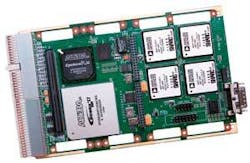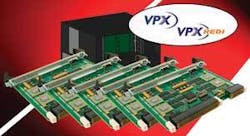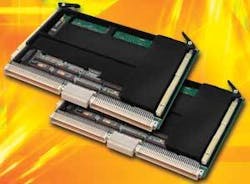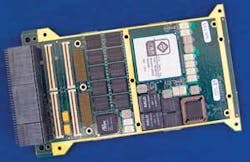Embedded-system vendors are releasing their products based on the proposed VITA 46 (VPX) standard, while traditional VME standards such as VME 64 continue to prove profitable. Meanwhile, across the standards aisle, the PICMG MicroTCA standard is creating a buzz in military circles.
By John McHale
For the last few years, designers of VME bus architectures grappled with ways to enable their technology, expertise, and companies to survive in a future in which performance requirements of electronic military systems exceeded the levels that VME could obtain.
The debates and planning began with the introduction of switched-fabric architectures that enabled much more I/O and performance in bus systems. The intermediate result was the VITA 41 standard or VXS, now already deployed in military applications.
However, while this was still the VME architecture tweaked to work with fabrics, it still did not embrace the supercomputing capability that very high-speed fabrics would bring.
The result is a proposed standard from the VITA Standards Organization (VSO) in Fountain Hills, Ariz., originally titled VITA 46 and now dubbed VPX. Products based on VPX and its complement, VPX-REDI (VITA 48) had their coming-out party in January at the bus industry’s annual debutante ball-the Bus and Board Conference in Long Beach, Calif.
VME and VITA are like a Swiss army knife that keeps building new arms and legs to keep its technology and vendors in the game, says Stewart Dewar, product-marketing manager at Curtiss-Wright Controls Embedded Computing in Leesburg, Va. However, VPX can do so much more because of its massive I/O advantage, says Eran Strod, director of product marketing for the defense business at Mercury Computer Systems in Chemlsford, Mass.
The specs for VITA 46 and VITA 48 are still in the process of being completed, says Ray Alderman, executive director for VITA. It has been on the street for several years and most of the software issues have been resolved, he adds.
By this spring VPX should be an ANSII standard, Dewar says.
In the end it is standards that create markets not technology, Alderman says, which is why you will see more of a market for VPX after the standard is completed. This is also why traditional VME is still strong-it is reliable, standardized, and the military knows it will work.
“In terms of technology you look at companies and you have sprinters and marathoners,” Alderman says. VME and military COTS technologies are marathoners, while telecom products are sprinters, he continues. Sprinters want to get to market quickly and expect to have large volumes and large profits quickly, while marathoners keep on evaluating the product and are more concerned with making it last long-term than in how fast they can get it to market.
Dewar and Curtiss-Wright presented a public demonstration of an embedded system based on the high-bandwidth VPX (VITA 46) open-architecture bus standard at the conference.
“Customers need the previously unattainable bandwidth that VPX delivers to keep up with the ever increasing amount of data generated in today’s network-centric battlefield,” says Lynn Patterson, vice president and general manager of modular solutions at Curtiss-Wright Controls Embedded Computing. “Applications such as electronic warfare and radar processing have pushed beyond the limits of VME.”
Curtiss-Wright’s demonstration comprised a system using several of the company’s 6U form factor VPX boards. The system featured a VPX6-185 single board computer (SBC) and two CHAMP-AV6 digital signal processor (DSP) VPX boards operating in a mesh Serial RapidIO network. Each board in the mesh was connected to each of the others by a bidirectional x4 Serial RapidIO connection, with each link providing as much as 2.5 gigabytes per second of bidirectional bandwidth.
An application running on the system enabled viewers of the demonstration to choose the number of processors participating in simultaneous streaming transfers between the boards. This application represents common signal processing algorithms associated with radar processing that often are limited by data movement in traditional systems. The demonstration was able to show transfer rates approaching 2.5 gigabytes per second-the theoretical limits of the links-says Ian Stalker, DSP product manager for Curtiss-Wright.
Stalker says the Curtiss-Wright VPX product is already in a defense application, but declined to give specifics due to contractual obligations.
The VPX and VPX-REDI standards were developed collaboratively by prime military integrators and other bus industry leaders, to provide military and aerospace system integrators with a more capable module standard that allows for better exploitation of new technologies while enabling more cost-effective end systems, Curtiss-Wright officials say.
The VPX standards provide the next generation of performance and rugged packaging for 6U and 3U form factor embedded computing with backplane I/O connectivity. VPS also offers improved thermal management, built-in electro-static discharge protection, and support for LRM (line replaceable module)-level in-the-field repair and replacement, says John Wemekamp, chief technology officer for Curtiss-Wright Controls Embedded Computing. These bus standards, available in conduction-cooled and air-cooled form factors, increase the total amount of data bandwidth compared to the earlier VME64x bus architecture.
VPX and VPX-REDI enable high-speed serial interconnects with a form factor and feature set designed to meet military and aerospace applications. Their use of a new connector type, Tyco’s 7-row, wafer-style MultiGig RT2, enables boards based on these standards to support data rates up to 6.25 gigabits per second. This renders VPX suitable for serial switched fabrics such as PCI Express and Serial RapidIO. These serial-switched fabrics are quickly moving into military and aerospace platforms and their subsystems, Wemekamp says.
At Bus and Board, GE Fanuc Embedded Systems in Albuquerque, N.M., also announced the company’s latest VPX products, the SBC330, a PowerPC 8641D-based single-board computer; the SDD910 is a SATA disk-drive module; and the PEX430 serves as four-port, four-lane PCI Express switch and as a PMC/XMC carrier card. The three products join the previously-announced SBC340 single-board computer based on Intel Core Duo technology; the GRA110 graphics processor, featuring the NVIDIA G73 GPU; and the GBX410 16-port Gigabit Ethernet switch. Radstone Embedded Computing-recently acquired by GE Fanuc-announced the first products in its 6U VPX family in November.
“It’s important to know that we have whole-heartedly embraced 3U VPX not just because it is an industry standard, but because we firmly believe that it delivers significant benefits in terms of the leading-edge performance, compact size, low weight, and the flexibility that our customers demand,” says Simon Collins, product manager at GE Fanuc Embedded Systems. “It is now possible for prime contractors and application developers to configure a complete 3U VPX system from GE Fanuc Embedded Systems that delivers the processing, graphics, and communications power required by today’s most demanding military computing applications.”
Radstone’s VPX roadmap was a key attraction for GE Fanuc when it decided to purchase the company, says Rob McKeel, vice president of GE Fanuc Embedded Systems.
Traditional VME still a profit maker
“VITA 41 (VXS) is here and products are being built on it,” says Doug Patterson, vice president of sales and marketing for Aitech in Chatsworth, Calif. At some point and time you have to build what the customers want and they want VXS, 6U VME 64, and 3U CompactPCI, he says.
The military is slow to adapt because technology failure is not an option, and military leaders need to trust their systems. VME 64 and VXS have that trust, while VPX will still need to prove itself.
Aitech upgraded several aspects of the company’s C10x series of 6U single-slot VME single-board computers to provide increased processing power and onboard capabilities. The series upgrades include an increase in Flash File memory to 4 gigabytes in four Aitech products: the standard C100, the high-performance C101, the low-power C103, and the C106 with PCI on the P0 connector. Technological improvements to the C10x series also include a newer processor for the C100 and C101, from the PowerPC G4+ MPC7455 processor to the MPC7457, operating at more than 733MHz.
When warfighters are running their fire-control system on a moving tank and acquire their target they cannot have the processor board malfunction when it goes over rough terrain, throwing off their aim, Patterson says. They need reliable technology, which is what VME is and why orders are still high and will be for some time, he adds.
“We still continue to see VSX and VME64 DSP product orders,” Dewar says. VME64 has been there for years and VSX set the framework for VPX, he adds.
“We still plan on new VME products,” Stalker says. There are still lots of opportunities for VME in applications where there is no need to migrate to VPX, he adds. Stalker says customers also see a strong cost/performance benefit for embedded applications with 3U CompactPCI products.
Another demonstration of VME64’s viability was made by Thales Computers in Edison, N.J., and the 3M Electronics unit in Austin, Texas. They presented an upgrade solution for VITA 1.1 applications using the two millimeter hard metric P0 connector present in most existing VME systems today. Thales presented the solution during the Bus and Board event, an implementation of the PCI Express high-speed interconnection between 6U VME boards.
“Once again the VME ecosystem demonstrated its extraordinary vitality by achieving major technology improvements while retaining backward compatibility,” says Robert Negre, chief technical officer of Thales Computers. “We have been working on this for quite some time now and have mastered end-to-end solutions for both RapidIO and PCI Express interconnects on the current VME64x backplane. This becomes a big asset in situations where switching to newer connector technology in the system is not an option.”
Using a flexible and modular high- speed connector technology from 3M Electronics-the high-speed hard metric (HSHM) implemented on computer boards-Thales Computers can now offer a multigigabit-per-second interconnection solution compatible with the existing VME infrastructure, Negre says.
VMETRO officials in Houston have also found success with their VXS products, says Tom Bohman, vice president of business development at VMETRO. The company’s Vortex M6000 VME/VXS recorder “enables data recorders to be used in high-speed serial-interconnect environments through VXS and XMC I/O ports,” Bohman says. “An enormous number of applications can be met with air or conduction cooled Vortex recorders combined with Fibre Channel storage devices that range from commercial drives to rugged drives to sealed drives and flash solid-state drives.”
The current question is what the military specifications will look like and where the funding will go, especially in the era of cutbacks with programs such as Future Combat Systems, Alderman says. “My guess is continued funding for programs that use VME64 and VXS.”
VME will be strong for another 25 years because if the big programs get cut then VPX integration can be stalled but traditional VME will benefit, Alderman continues. “I still see a warm and fuzzy future for VME.”
MicroTCA creating buzz with military potential
Another standard gaining attention is the Micro Telecommunications Computing Architecture (MicroTCA), standardized by the PCI Industrial Computer Manufacturers Group (PICMG) in Wakefield, Mass. This embedded PICMG standard promises to bring large performance benefits to military applications.
However, there are many challenges to implementing the standard for use in military systems, especially when it comes to ruggedization and cooling.
The MicroTCA specification defines systems that accommodate plug-in cards complying with the successful Advanced Mezzanine Card specification. These cards, which were originally designed as daughter boards, plug directly into a MicroTCA system backplane, thus extending the market for AdvancedMC cards and providing an existing supplier base for MicroTCA, according to PICMG officials. The specification incorporates the system management and fabric features from AdvancedTCA into platform that is scalable from small, cost-effective systems to available redundant systems. MicroTCA brings the robustness and reliability of the AdvancedTCA approach to market segments requiring a small footprint such as access and edge applications in telecom networks.
“I’m hot on MicroTCA,” says Jeff Milrod, president and chief executive officer of Bittware in Concord, N.H. He says he sees it in next-generation systems if the ruggedization issues can be solved. Also, once ruggedized, it could give 3U VPX products some competition, he adds.
Two ruggedization efforts are in special interest groups (SIGs) that are working on different solutions to the cooling and ruggedization challenges, says Joe Pavlat, president of PICMG.
One of these SIGs is led by Hybricon and Motorola Computer Group in Tempe, Ariz. Hybricon introduced a ruggedized MicroTCA chassis last fall that accommodates double-width modules. This ruggedized ATR (air-transport-rack) platform remains compliant with the specification, and addresses key limitations of commercial MicroTCA for military applications, Hybricon officials say.
Based on customer feedback, Hybricon officials say they believe that the combination of WiMAX and ruggedized MicroTCA is an attractive open-standards COTS-based wireless solution for many military applications.
Additional features include locking bars that firmly retain the MicroTCA cards into the card cage, providing significant additional resistance to shock and vibration; a shock-isolated MicroTCA card cage inside the ruggedized ATR chassis that attenuates the level of shock and vibration on the MicroTCA cards, allowing the chassis to meet stringent ANSI/VITA 47 and MIL-STD-810 shock and vibration requirements; and MIL-STD-461 EMI/EMC containment.
The Hybricon chassis also uses military circular connectors for copper and fiber I/O. This I/O can be tailored for specific applications. Power-supply front-end converters also can be configured for commercial power, MIL-STD-704 aircraft power, or MIL-STD-1275 vehicle power.
Pavlat says he expects the Hybricon solution and other methods will eventually converge to make MicroTCA viable for rugged applications, Pavlat says. It may take at least a year, he adds.
The AdvancedTCA standard also is seeing applications in the military space, says Dave Purlsey, pre-application sales engineer at Kontron in Poway, Calif. While its size does not make AdvancedTCA products for many military programs, it has landed in a few simulation systems, he says.
Pavlat sees not just telecom standards and products such as MicroTCA making headway in the military market but design approaches as well.
There is a push toward high availability in building mission-critical systems because it does not have one single fault like many systems that use mean time between failure as a measurement of reliability, Pavlat says. Telecom was based on redundancy with systems having two or three of everything so they can last 30 years or more, he continues. This method, while expensive, is attractive to military designers due to its resulting reliability, Pavlat adds.
Employees purchase Sky Computers from parent Analogic Corp.
Former employees of Sky Computers Inc., in Chelmsford, Mass., have purchased the company from Analogic in Peabody, Mass. Sky is a supplier of standards-based, high-performance embedded computer systems for radar, sonar, semiconductor, and industrial inspection applications.
Upon completion of the acquisition, the company has relocated its corporate headquarters to Chelmsford, Mass., from the Analogic corporate offices in Peabody, Mass.
As a wholly-owned subsidiary of Analogic, Sky has been focused on the custom manufacturing and servicing of its installed customer base. Under its new ownership, Sky Computers will resume its product-development initiatives and enhancements. In addition to furnishing hardware support for Sky’s installed base for the SKYchannel product line, the new ownership will service and support the SKYchannel architecture and the newer, Linux-based SMARTpac models. The company will also continue to provide complete system integration services. While continuing to service Sky’s existing customer base, the Sky team plans to announce regular product initiatives in the near future.
“After a brief hiatus, we are pleased to have Sky Computers fully operational again,” says Henry Shean, president and chief executive officer of Sky. “Our team includes a talented, experienced group of individuals who know the technology and the industry. We will continue to offer our customers the full range of services and support and technical excellence that Sky has been known for, but now our customers will benefit from our rededication to product design and innovation.”
The ownership of the reorganized Sky Computers is made up of employees who were involved in the management, product development, and operations of the new company. The purchase price was not disclosed.
The product lines, based on industry-standard architectures, are SKYchannel (VME) and SMARTpac (infiniband). The company also provides system integration services.
Analogic Corp. designs and manufactures advanced health and security systems and subsystems sold primarily to Original Equipment Manufacturers (OEMs).
VPX Offerings
During Bus and Board conference some companies presented their VPX product offerings.
Hybricon Corp. in Ayer, Mass., announced the release of a VPX REDI Desktop Development Platform designed for today’s high-power VPX REDI boards. The power-dissipation levels of today’s emerging high-power VITA 46 VPX switch-fabric boards just keep increasing; in the past few years power dissipation in the 50- to 100-watt range was the norm, now the range is increasing to between 75 and 150 watts, Hybricon officials say. Up until now, these 75-150-watt boards could only be adequately cooled in high-performance full-size rack-mount enclosures. This can now be accomplished in Hybricon’s Portable VPX REDI desktop style enclosure.
The VPX REDI desktop enclosure is targeted at system engineers and software developers for lab use, and it is designed to the latest VITA 46.0, VITA 46.3, VITA 46.10, VITA 48.0, and VITA 48.1 draft standards. The backplane provides six slots based on VITA 48.1 VPX REDI with 1.0-inch pitch, including support for 80 mm rear transition modules. Part of Hybricon’s extreme-cooling chassis family, the chassis has a 1.9 kW power supply and high-performance fans with 18 CFM per slot to power and cool VPX boards. The enclosures are available with 2k watts of power.
A Hybricon chassis is used by Curtiss-Wright Controls Embedded Computing in Leesburg, Va., for its VPX 6-Slot Lab Chassis, a VPX and VPX-REDI (VITA 46/VITA 48) chassis, designed to ease the development of software for embedded systems based on the high-bandwidth VPX standards. The VPX 6-Slot Lab Chassis is designed to support software development using Curtis-Wright’s VPX (VITA 46/48) processing modules such as the VPX6-185 single-board computer (SBC) and the CHAMP-AV6 quad digital-signal-processing (DSP) engine cards. Curtiss-Wright will offer the chassis as a development system preconfigured with one or more of its VPX and VPX-REDI SBC and DSP boards.
Micro Memory in Chatsworth, Calif. offers the CoSine-on-Othello MM-15x0 and MM-16x0 VME carriers for FPGA processing on serial-switch fabrics. The solution combines the CoSine system-on-chip solution with the application optimized architectures of Othello VME carriers for the VXS VITA 41 and VPX VITA 46 serial link formats. The MM-15x0 and MM-16x0 support continuous data streams through independent, nonblocking pathways. Targeting applications such as synthetic aperture and phased-array radar, software-defined radio, signal intelligence, and semiconductor and medical imaging, the MM-15x0 and MM-16x0 utilize field-programmable gate arrays (FPGAs) for DSP operations such as FFTs, filters, and image or data compression to provide significant performance benefits over conventional DSPs or general-purpose embedded RISC processors. The MM-1500 and MM-1600D also include the V-4 SX series of FPGAs from Xilinx.
Mercury Computer Systems in Chelmsford, Mass., produces the PowerStream 6600 multicomputer, with 716 PowerPC GFLOPS of compute performance in a conduction-cooled enclosure, to enable powerful sensor computing on the move. The performance density and rugged mechanical design of the PowerStream 6600 enables manned and unmanned vehicles to support C4ISR (command, control, communication, computers, information, surveillance, and reconnaissance) multimode missions. These include radar, and image and signals-intelligence (SIGINT) processing.
“The PowerStream 6600 contains the enabling hardware and software building blocks necessary for mission systems to perform compute-intensive tasks, such as processing a 3-D radar data cube, in real time,” says Eran Strod, director of product marketing for the defense business at Mercury.
The 16-slot PowerStream 6600 is a complete system computing solution with data acquisition, high-speed I/O, PowerPC compute clusters, and FPGA processing integrated with open-standard software. From the inside out, the PowerStream 6600 is built using open and de facto standards: the Linux and VxWorks operating systems, Internet Protocol (IP), VPX-REDI (VITA 46 and 48), PMC-X/XMC, Ethernet, and the RapidIO interconnect fabric. The PowerStream 6600 is aligned with open standards initiatives such as the Navy’s Open Architecture Computing Environment (OACE).
Elma Electronic in Fremont, Calif., announced its VPX Portable Tower at Bus and Board. The chassis features a mesh backplane compliant to the latest VITA 46 specifications. The VPX Tower offers a carrying handle for easy portability making it ideal for prototyping, demonstrations, and for mobile applications, Elma officials say. The unit also features advanced EMC shielding, scratch-resistant vinyl-clad aluminum covers, and power components. Cooling is achieved with 1 x 12V DC fan pushing 150 CFM (cubic feet per minute) in a front-to-rear airflow configuration. As VPX offers a wide range of power options, a flexible 800-watt power supply with various input voltages is included. The first configuration of the VPX Tower is a 5-slot mesh backplane from Elma Bustronic.
Parker Hannifin in Woburn, Mass., presented its standards-based-technology liquid-cooling demonstrator for high-power embedded electronics applications to support manufacturers and users of open-system architectures. Designed with the defense and aerospace communities in mind, the product being demonstrated is called a liquid-flow-through (LFT) electronics chassis.
Parker’s LFT chassis is capable of cooling up to a maximum of 850 watts per slot, a total of 2,000 watts with dielectric fluids such as hydrofluoroethers (HFE) and synthetic oil (PAO), or 4,000 watts with nondielectric fluids such as water or water/glycol mixtures.
The product can be scaled to accommodate the required amount of technology integration for individual applications, and is hybrid-backplane capable to accommodate any board technology, including VME, VITA 41/VXS, and VITA 46-48/VPX REDI.
The XPedite8070 from Extreme Engineering in Madison, Wis., is a high-performance 3U VPX-REDI single-board computer that is for ruggedized systems requiring high-bandwidth processing and low power consumption. It has two PA Semi PA6T cores running as fast as 2.0 GHz while dissipating less than 17 watts. The PA Semi PA6T-1682 PWRficient integrated platform processor combines dual PA6T cores, and high-performance communication to two DDR2 SDRAM channels, and a variety of network interfaces.
XPedite8070 supports two separate channels of as much as 1 GB each of 400-MHz DDR2 ECC SDRAM, as well as up to 1 GB of NAND Flash. XPedite8070 provides the option of utilizing PCI Express, 10 Gigabit Ethernet XAUI, and Gigabit Ethernet P1 interconnects. XPedite8070 also supports dual Gigabit Ethernet, GPIO, I2C, PMC I/O, XMC I/O, and dual RS-232/RS-422 ports out the P2 connector.










